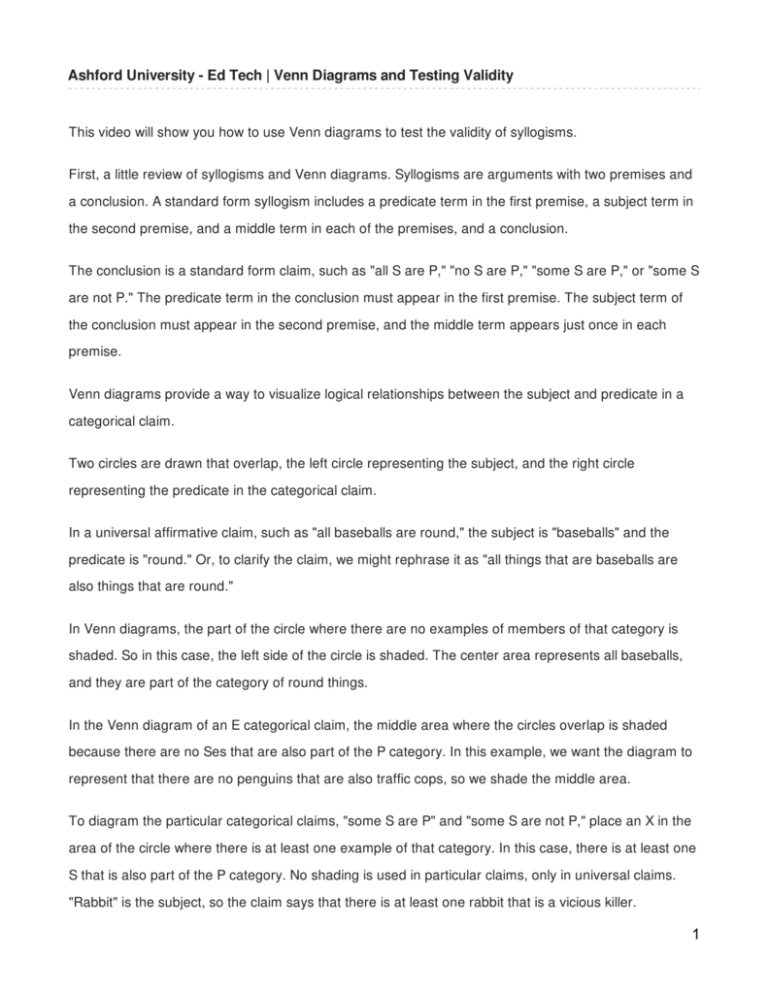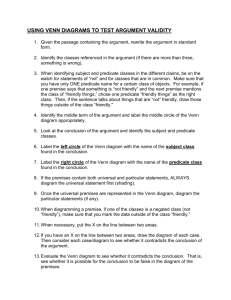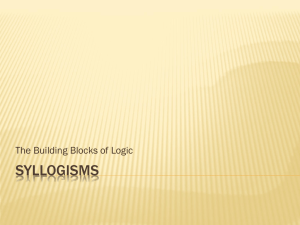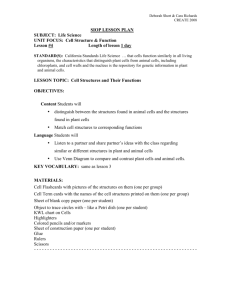Ashford University - Ed Tech | Venn Diagrams and
advertisement

Ashford University - Ed Tech | Venn Diagrams and Testing Validity This video will show you how to use Venn diagrams to test the validity of syllogisms. First, a little review of syllogisms and Venn diagrams. Syllogisms are arguments with two premises and a conclusion. A standard form syllogism includes a predicate term in the first premise, a subject term in the second premise, and a middle term in each of the premises, and a conclusion. The conclusion is a standard form claim, such as "all S are P," "no S are P," "some S are P," or "some S are not P." The predicate term in the conclusion must appear in the first premise. The subject term of the conclusion must appear in the second premise, and the middle term appears just once in each premise. Venn diagrams provide a way to visualize logical relationships between the subject and predicate in a categorical claim. Two circles are drawn that overlap, the left circle representing the subject, and the right circle representing the predicate in the categorical claim. In a universal affirmative claim, such as "all baseballs are round," the subject is "baseballs" and the predicate is "round." Or, to clarify the claim, we might rephrase it as "all things that are baseballs are also things that are round." In Venn diagrams, the part of the circle where there are no examples of members of that category is shaded. So in this case, the left side of the circle is shaded. The center area represents all baseballs, and they are part of the category of round things. In the Venn diagram of an E categorical claim, the middle area where the circles overlap is shaded because there are no Ses that are also part of the P category. In this example, we want the diagram to represent that there are no penguins that are also traffic cops, so we shade the middle area. To diagram the particular categorical claims, "some S are P" and "some S are not P," place an X in the area of the circle where there is at least one example of that category. In this case, there is at least one S that is also part of the P category. No shading is used in particular claims, only in universal claims. "Rabbit" is the subject, so the claim says that there is at least one rabbit that is a vicious killer. 1 To diagram the O claim "some S are not P," the X is placed inside the S category but outside the P category. This indicates there is at least one S that is not a P. For instance, this would be the diagram of the O claim "some college students are not millionaires." To use a Venn diagram to represent a syllogism requires three circles, because there are three different terms in a syllogism-- the subject, predicate, and middle term. Since the circles form more overlapping areas, it is convenient to number the areas for easy reference. Usually the numbering begins with the top circle, which represents the middle term. Let's walk through the process of diagramming a syllogism with two premises that are A claims. The conclusion is never represented in a Venn diagram of a syllogism, since the conclusion of a valid syllogism is the result of the premises. The conclusion is what the Venn diagrams should say after we diagram the premises of a valid argument. Although the conclusion isn't diagrammed, remember that the subject and predicate terms of a syllogism are determined by the conclusion. Here's the Venn diagram of the first premise, "all P are M." Areas six and seven are shaded to indicate nothing is there. The only Ps are the ones in areas three and four, the areas that are also part of the M category. So areas three and four are not shaded. Now let's diagram the second claim, "all M are S." For "all M are S," areas one and four are shaded to indicate that part of the diagram doesn't have anything in it. Just areas two and three remain, indicating that these are the only areas of M that remain. Now that we've diagrammed the two premises, we can check the validity of the conclusion. We just need to see if the conclusion is consistent with the resulting diagram. It isn't. The conclusion says that all of the S category belongs to the P category. But there are two areas of the S category outside of P, areas two and five. So the syllogism is invalid. Let's test the validity of another syllogism, this time an argument that has particular claims in it-- "some P are M," "all M are S," "some S are P." This is a syllogism with the mood IAI and the figure four. Remember that we indicate a particular claim in a Venn diagram by drawing an X in the appropriate 2 area. The first premise says that there is at least one P that is an M. That means that an X goes in the part of the circle that overlaps the M circle, areas three or four. But which one? Area three, or four? Both are part of P that is also part of M. If we don't know which area to put the X, we draw it on the line between the two possible areas. Now for the second premise, "all M are S." Remember that we said that the area where there isn't anything, which in this case would be areas one and four, are shaded. So we should shade areas one and four, but there's a problem. We've already added the X on the line between three and four to indicate it could be in either one, but area four is supposed to be empty. So we have to redraw the X and place it just in area three, then shade areas one and four. Now both premises are displayed. However, there is an easier way to draw them. If you have a particular and a universal claim in the premises, draw the universal claim in the Venn diagram first. Then you won't have to move the X. Is this syllogism valid? Does the Venn diagram say "some S are P?" Yes. There is an X in area three, indicating that there is at least one S that is also a P. The syllogism is valid. In summary, use three circles in a Venn diagram to represent subject, predicate, and middle term. Number the circles beginning with the top circle. Draw the diagram to represent each of the two premises but not the conclusion. If an argument has universal and particular premises, draw the universal premise first. Use an X to indicate "at least one," and place it on the line between two areas if it isn't clear which side of the line it should be. After diagramming the premises, see if the conclusion is consistent with the drawing. If it is, the syllogism is valid. If not, the syllogism is invalid. Thanks for watching. 3








